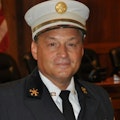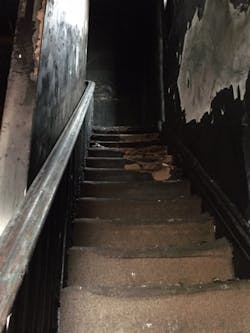Interior stairs must be kept open. How many times did you see or were you one of the firefighters who were standing on each and every step in the building waiting to get to the fire floor and go to work?
Now, we all know why this happens, and it’s rewarding to see the dedication and determination to go to work, but as a boss, it’s your responsibility to remind your people that everyone might not get into the game. You are obligated to do a better job at managing the team.
How not to botch the stairwell
What’s described above presents a major concern on the fireground. If you ever were part of it, you probably can anticipate what I am going to say: When things go bad on the fire floor (flashover) or if a member has a mask (SCBA) malfunction and that individual must exit quickly, stairwell mismanagement can be catastrophic. The bottom line: For members to need to quickly exit and leave the fire floor only to be caught in a massive traffic jam on the stairs is unacceptable. At many incidents, it caused severe injury, as members attempted to dive over the conga line of firefighters who are standing on each step and stair landing. In my 40-plus years in the fire service, I have had this conversation and stressed this concern numerous times before and after incidents.
So, how can you address this circumstance before it becomes a problem? Consider the following three approaches:
Only assign what you need. It all starts with the incident commander (IC). To put it bluntly, only assign what you need. If you have a small army of firefighters show up for what initially is identified as “food on the stove,” obviously, all you need are the resources of one engine and one ladder company, with everybody else staying outside to wait further assignments. Even if that same army shows up to a working fire, with fire showing out of two windows on the second floor of a private dwelling, you don’t need to send in the entire army. Use and/or assign what you need, and no more.
Management via radio. To further assist with scene management, many fire departments, including my own, require the IC to give a brief initial radio communication within the first few minutes of arrival to describe conditions and actions. To further illustrate this, the following is a sample radio transmission of what this might sound like:
“Fire dispatch from Battalion 4. At Box 579. We are using Engine 15 and Ladder 9 for a smoke condition on the third floor of a five-story Class 3 multiple dwelling. The rest of the assignment is staged.”
What this does in its simplest design is assign/inform who should be in the building and who shouldn’t be. If you aren’t assigned to Engine 15 or Ladder 9 and you are in the building when you hear this, your attempt at taking initiative can be viewed as freelancing.
Stair discipline. Every company and chief officer who is assigned to the inside of the building has an obligation to keep the stairs that lead up to the fire floor clear of all firefighters. During a fire fight, firefighters and their officers must stage on the floor below the fire floor and wait to be called up to go to work. When I assigned a battalion chief to coordinate the operations on the inside of the building, stairwell management was one of the key responsibilities of that individual. However, please note that it doesn’t have to be a chief officer. The officer of the fire company that’s next in line to proceed up must assume this responsibility as well. Just think of the consequences if this responsibility is ignored.
About the Author

Michael Terpak
Michael Terpak has been in the fire service for 45 years, spending the last 36 years with the Jersey City, NJ, Fire Department, where he recently retired as a deputy chief and citywide tour commander. Terpak travels extensively, lecturing on fire/rescue topics. He is the founder of Promotional Prep, which is a New Jersey-based consulting firm that's designed to prepare firefighters and fire officers who are studying for promotional exams. Terpak, who holds a bachelor’s degree in fire safety administration from the City University of New Jersey, is the author of five books: "Fire Ground Size-Up" (first and second editions), "Assessment Center Strategy and Tactics," "Fire Ground Operational Guides," "Assessment Center Management and Supervision" and "Fire Officer Oral Assessment Study Guides."
